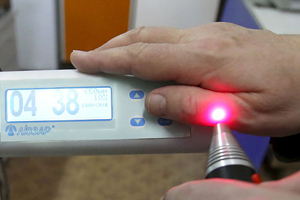Ru
|
Eng
Belarus develops novel device to treat wounds and ulcers
10.03.2014

The Stepanov Institute of Physics of the National Academy of Sciences of Belarus (NASB) jointly with the country’s leading healthcare institutions have come up with a new technology to treat septic wounds, trophic ulcers and other diseases, BelTA learnt from Deputy Director for Innovations and Research of the Stepanov Institute of Physics Vitaly Plavsky.
The technology is called antimicrobial photodynamic therapy. The scientists developed a special laser device and photosensitizers based on registered drugs to be used on target areas. The new technology allows treating a wound by applying drugs locally to the target area and exposing this area to the laser light. “The procedure is comfortable, painless, effective and has no complications,” Vitaly Plavsky said.
In his words, one of the applications of the technology is the treatment of gastric ulcers. A special tube is inserted into the stomach to deliver drugs that will prepare the target area for the treatment. After that a thin wire is passed through the tube to deliver the laser light. The procedure takes just one minute. Only two procedures are needed to cure gastric ulcer. “This method will allow us to stop using drugs based on heavy metals that are detrimental to health. This method is already used to treat gastric ulcers in children in the Vitebsk Oblast Children’s Hospital,” Vitaly Plavsky added.
The major advantage of this method is its ability to treat drug-resistant pathogens, because pathogens cannot resist the reactive oxygen species that are produced during the exposure of photosensitizers to laser light. “No radiation is used, only light. The light helps excite the drugs, thus reducing the time needed to treat a disease. A person is cured much faster,” Vitaly Plavsky said.
Antimicrobial photodynamic therapy can be used in cosmetology to treat acne and in dentistry. Guidelines describing the treatment procedure were developed jointly with the Healthcare Ministry. Although this is a novel therapy, it is widely used by domestic healthcare institutions.
All the equipment has been certified and mass production has been launched. About 150 devices are to be supplied in 2014. The new equipment might also be exported to Russia.
The technology is called antimicrobial photodynamic therapy. The scientists developed a special laser device and photosensitizers based on registered drugs to be used on target areas. The new technology allows treating a wound by applying drugs locally to the target area and exposing this area to the laser light. “The procedure is comfortable, painless, effective and has no complications,” Vitaly Plavsky said.
In his words, one of the applications of the technology is the treatment of gastric ulcers. A special tube is inserted into the stomach to deliver drugs that will prepare the target area for the treatment. After that a thin wire is passed through the tube to deliver the laser light. The procedure takes just one minute. Only two procedures are needed to cure gastric ulcer. “This method will allow us to stop using drugs based on heavy metals that are detrimental to health. This method is already used to treat gastric ulcers in children in the Vitebsk Oblast Children’s Hospital,” Vitaly Plavsky added.
The major advantage of this method is its ability to treat drug-resistant pathogens, because pathogens cannot resist the reactive oxygen species that are produced during the exposure of photosensitizers to laser light. “No radiation is used, only light. The light helps excite the drugs, thus reducing the time needed to treat a disease. A person is cured much faster,” Vitaly Plavsky said.
Antimicrobial photodynamic therapy can be used in cosmetology to treat acne and in dentistry. Guidelines describing the treatment procedure were developed jointly with the Healthcare Ministry. Although this is a novel therapy, it is widely used by domestic healthcare institutions.
All the equipment has been certified and mass production has been launched. About 150 devices are to be supplied in 2014. The new equipment might also be exported to Russia.
SCIENCE. TECHNOLOGY. INNOVATIONS
13.08.2024
28.06.2024
28.06.2024
25.06.2024
05.06.2024
15.05.2024
15.05.2024
26.04.2024
26.04.2024
26.04.2024













